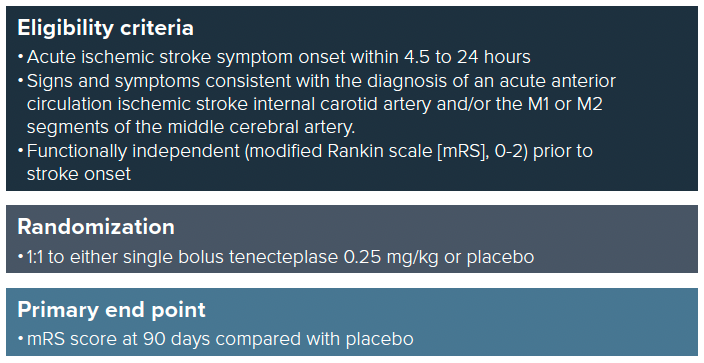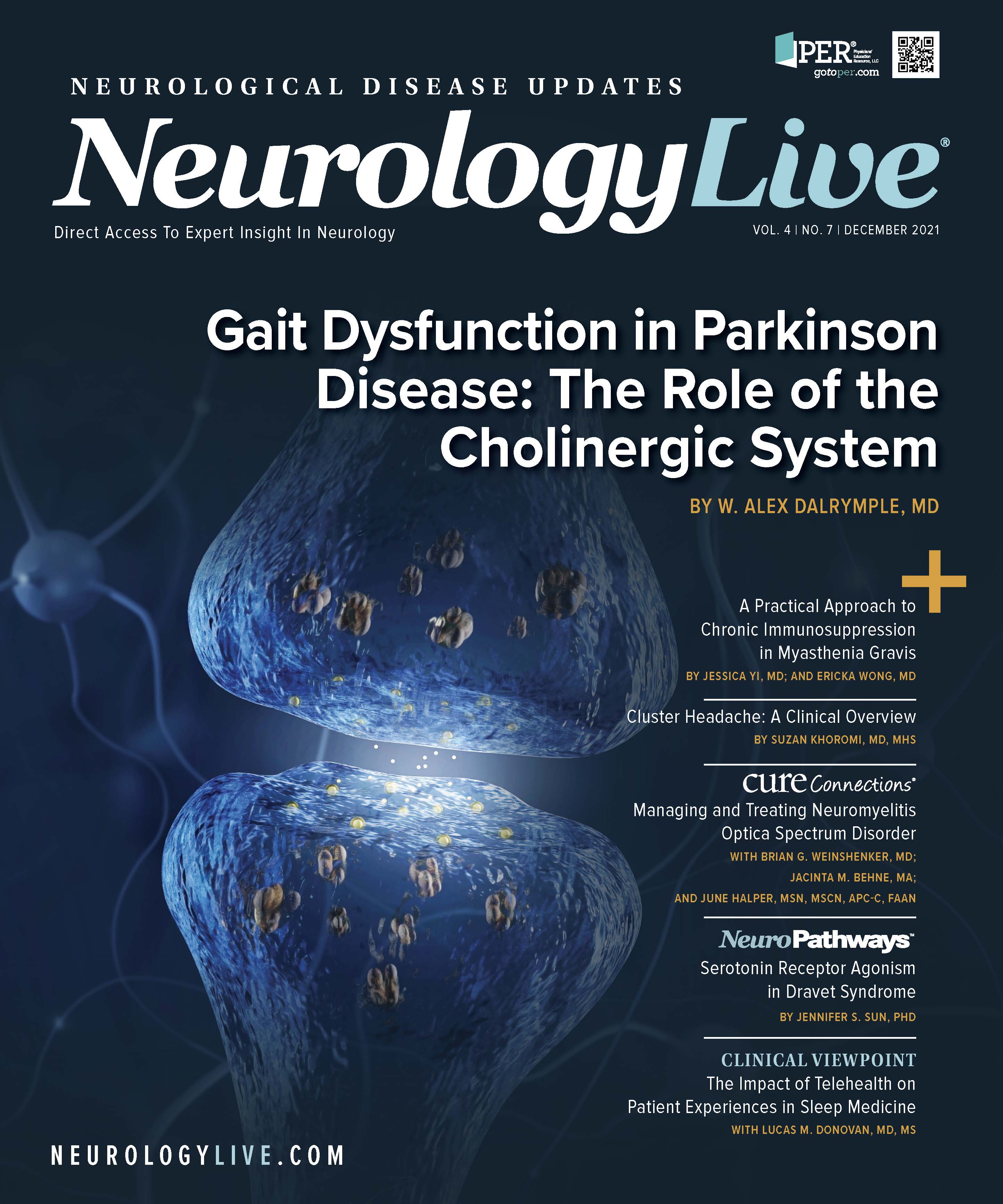Publication
Article
NeurologyLive
Confirming the Benefits of Tenecteplase for Acute Ischemic Stroke in TIMELESS
Author(s):
After years of research showing that it demonstrates similar benefit to alteplase, tenecteplase’s benefit in a large patient cohort with acute ischemic stroke will be tested in the TIMELESS trial.
Gregory W. Albers, MD

THE PHASE 3 TRIAL CALLED Thrombolysis in Imaging-eligible, Late-window Patients to Assess the Efficacy and Safety of Tenecteplase (TNKase; Genentech), or TIMELESS (NCT03785678), will evaluate tenecteplase, an FDA-approved therapy for myocardial infarction, as a treatment for patients with acute ischemic stroke (AIS).
Tenecteplase is a tissue plasminogen activator (tPA) developed from modifications of natural human tPA complementary DNA. It binds to fibrin-rich clots and cleaves the Arg/Val bond in plasminogen to form plasmin, which then degrades the fibrin matrix of the thrombus, thereby exerting its thrombolytic action. For years, evidence has mounted that tenecteplase could offer similar benefit to alteplase, the only FDA-approved thrombolytic medication for AIS; however, large clinical studies confirming this benefit were still needed.
Approximately 456 participants will be included in TIMELESS, with ordinal modified Rankin scale (mRS) score at 90 days as the primary end point. The investigator team—which includes Gregory W. Albers, MD, director of the Stanford Stroke Center as well as Coyote Foundation Professor of Neurology and Neurological Sciences at Stanford Medical Center—will also assess several other secondary end points. These include proportion of patients with functional dependence, defined as an mRS score of 0 to 2; proportion of patients with angiographic reperfusion; and median National Institutes of Health Status Scale score, among others.1
Patients must be aged at least 18 years, have AIS symptom onset that began within 4.5 to 24 hours, signs and symptoms that are consistent with the diagnosis of an anterior circulation ischemic stroke involving occlusion of the internal carotid artery and/or the M1 or M2 segments of the middle cerebral artery, and be functionally independent (mRS, 0-2) prior to stroke onset (FIGURE).
FIGURE. TIMELESS Trial of Tenecteplase

All patients will receive standard-of-care therapy according to the American Heart Association/American Stroke Association clinical guidelines from 2018. In one treatment arm, patients will receive tenecteplase 0.25 mg/kg administered as a single bolus injection over 5 seconds. Patients in the other treatment arm will receive placebo since a thrombolytic is FDA approved in the United States for use only out to 3 hours, and the standard-of-care guidelines support use out to 4.5 hours.
Alteplase, an intravenously (IV) administered medication, has practical issues that have forced clinicians to explore the use of tenecteplase in the acute setting. Thus far, research has suggested that tenecteplase is as efficacious as alteplase with regard to neurologic improvement, and its theoretical advantages include greater fibrin specificity and longer half-life.2
A meta-analysis published in 2019 confirmed these thoughts. Using 5 randomized trials, investigators compared the 2 treatments on freedom from disability, measured by scores of 0 to 1 on mRS at 3 months, as the primary end point. In total, 57.9% of those on tenecteplase (standard 0.1 mg/kg dosing) vs 55.4% of those on alteplase (0.9 mg/kg) achieved this goal.3
Tenecteplase has a few advantages over alteplase. First, administration is more practical: single bolus, vs bolus plus 1-hour infusion with alteplase. Additionally, the administration of alteplase drip requires an IV pump. Not all emergency medical technicians are qualified to manage IV pumps, which may, in certain circumstances, delay or complicate a patient’s interfacility transfer. Tenecteplase also lacks the nonnegotiable risk of symptomatic intracranial hemorrhage, and limited efficacy in the rate of vessel recanalization, especially with large vessel occlusion, that is observed with alteplase.
The results of the EXTEND-IA TNK study (NCT02388061), indicated that treatment with tenecteplase prior to thrombectomy is associated with a higher incidence of reperfusion and better functional outcome. The findings showed that 22% of those treated with tenecteplase vs 10% of those treated with alteplase met the primary end point of at least 50% reperfusion of the involved ischemic territory.4 Three randomized trials have also reported on the disparities in major bleeding between the 2 treatments. In the largest, ASSENT-2, patients with acute myocardial infarction randomized to tenecteplase had reduced rates of noncerebral bleeding complications (26.43% vs 28.95%; P = .0003) and less need for blood transfusion (4.25% vs 5.49%; P = .0002) compared with those on alteplase.5
The 2 treatment options have also been compared in a real-world setting. Results of a pilot observational study published earlier this year confirmed the same neurological improvements seen with tenecteplase over alteplase.6 This real-world observation included 19 patients on tenecteplase and 39 on alteplase, with the authors concluding that larger studies are needed.
REFERENCES
1. Clinical trials: tenecteplase in stroke patients between 4.5 and 24 hours. Stanford Health Care. Accessed November 12, 2021. https://stanfordhealthcare.org/trials/t/NCT03785678.html
2. Tanswell P, Modi N, Combs D, Danays T. Pharmacokinetics and pharmacodynamics of tenecteplase in fibrinolytic therapy of acute myocardial infarction. Clin Pharmacokinet. 2002;41(15):1229-1245. doi:10.2165/00003088-20041150-00001
3. Burgos AM, Saver JL. Evidence that tenecteplase is noninferior to alteplase for acute ischemic stroke: meta-analysis of 5 randomized trials. Stroke. 2019;50(8):2156-2162. doi:10.1161/STROKEAHA.119.025080
4. Campbell BCV, Mitchell PJ, Churilov L, et al; EXTEND-IA TNK Investigators. Tenecteplase versus alteplase before thrombectomy for ischemic stroke. N Engl J Med. 2018;378(17):1573-1582. doi:10.1056/NEJMoa1716405
5. Assessment of the Safety and Efficacy of a New Thrombolytic (ASSENT-2) Investigators; Van de Werf F, Adgey J, Ardissino D, et al. Single-bolus tenecteplase compared with front-loaded alteplase in acute myocardial infarction: the ASSENT-2 double-blind randomised trial. Lancet. 1999;354(9180):716-722. doi:10.1016/s0140-6736(99)07403-6
6. Psychogios K, Palaiodimou L, Katsanos AH, et al. Real-world comparative safety and efficacy of tenecteplase versus alteplase in acute ischemic patients with large vessel occlusion. Ther Adv Neurol Disord. 2021;14:1756286420986727. doi:10.1177/1756286420986727





